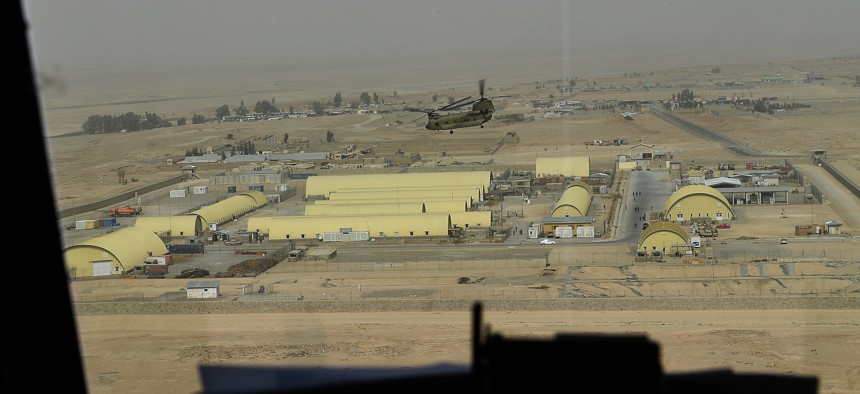
A CH-47 Chinook flies over a Forward Operating Base in Afghanistan Feb. 15, 2018. U.S. Air Force photo by Staff Sgt. Sean Martin
Trump's Aimless War in Afghanistan Expands, Again
Why is the U.S. bombing Chinese separatists, and what does it say about the flailing war effort in Afghanistan?
Last week, the Washington Post reported that the U.S. Air Force is now bombing Chinese Islamist separatists in a remote corner of Northeast Afghanistan. You’ve likely never heard of the group, the East Turkistan Islamic Movement (ETIM), nor should you have. These ethnic Uyghurs want to secede from China and form their own state in western Xinjiang province. They do not present any sort of existential threat to the United States. Sure, they’ve made common cause with Al Qaeda when it suited them, but overall, according to a terrorism analyst at the Woodrow Wilson Center, ETIM “typically has local aims.” Sounds to me like a China problem.
The Post report indicated just how far the U.S. effort in that country has gone off the rails—it is now almost entirely and openly disconnected from vital U.S. interests yet continues apace at a cost of $45 billion annually.
Remember, what began as a counterterror campaign to dislodge the Taliban and destroy Al Qaeda has gone through many permutations in the intervening decades. The U.S. tried—and failed—sequentially, at nation-building, counterinsurgency, and host-nation transition. So now, it appears, rather than targeting international terrorist threats that could target the United States (or its allies), Washington has ordered our military to bomb the heck out of anyone and everyone with vaguely Islamist credentials: the Taliban, ISIS, Al Qaeda (if there are any left), and, well, Chinese separatists.
President Trump’s Surge 5.0—which amounts to no more than a few thousand extra troops and loosened bombing restrictions—is really nothing new. These are old tactics masquerading as “new” strategy. U.S. commanders tout the “new authorities” bestowed upon them by President Trump last August, as though more bombs and more delegation of authority can substitute for an utter dearth of strategy in Afghanistan. Maj. Gen. James Hecker, commander of coalition air elements in country, eagerly told the Post, “With the current uplift in resources, we can decimate Taliban command-and-control nodes.” Leaving aside the overly sanguine, bellicose rhetoric, the general offers little in the way of evidence as to why this bombing—as compared to, say, the last 16 years’ worth—will have a positive strategic outcome.
The Post also quoted Brig. Gen. Lance Bunch, a director of future operations in Kabul: “We’ve got new authorities now that allow us to be able to…target the Taliban and ETIM where they previously thought they were safe.” Notice the conspicuous absence of Al Qaeda—the ostensible raison d’être for the whole Afghan adventure. That’s telling. Beyond the discredited fable of a supposed “safe haven” that endlessly blooms new bin Ladens, there’s actually very little of vital strategic interest in Afghanistan.
In a complex world with renewed concern about major powers, the Taliban, and most certainly the Chinese ETIM, poses a vanishingly minimal threat to our homeland. I fought the Taliban’s mostly illiterate, teenage farm boys in 2011-12, and their goals were strictly local. Besides, Afghanistan is no more of a safe haven than Yemen, Pakistan, Syria, Iraq, Libya, Niger…and on and on throughout the greater Middle East. For that matter, these are no more likely sanctuaries than Germany or the U.S., where, incidentally, the 9/11 plot was hatched. The U.S. patently lacks the manpower or resources to police each and every ungoverned space.
General Bunch also explained the immense scope of U.S. bombing efforts: “Anybody that is an enemy of Afghanistan, we’re going to target them.” Consider the audacity of such a statement. This flag officer, planning for future operations in America’s longest war, openly admits the bombing of ETIM is totally disconnected from U.S. security and that, essentially, the U.S. Air Force now acts on behalf of a highly corrupt, marginally legitimate Afghan central government
The generals interviewed admit that ETIM’s territory in the country’s northeast used to be “relatively peaceful,” and has only worsened since 2015. Why, one might reasonably ask, is a place that was once quite stable, 17 years into America’s intervention, significantly worse off? Could it be that the application of U.S. military power itself has stark limitations in remote Afghanistan?
After 16 years of training and equipping, and the reinforcement of up to 100,000 U.S. troops, the Afghan government still lacks the capability and legitimacy to hold on to most rural districts. That’s alarming and unlikely to turn around thanks to just a few more bombers and some unbridled, aggressive generals. When will Washington recognize that ungovernable spaces in 2018 may be ungoverned for a reason?
It’s long past time to pay attention to the world as it is. This much is certain, after 16 years, when no sector of even Kabul is safe, and U.S. operations have drifted to bombing obscure Chinese separatists, it is time to immediately explore extricating the U.S. from this entire endeavor.
The cognitive dissonance required to make sense of what passes for Afghanistan “strategy” in Washington is staggering. Let me get this straight: the U.S. is now combating groups that threaten China, the very country Secretary Mattis’ National Defense Strategy lists as America’s top “strategic competitor”?
As it stands, the United States military is fighting just about everyone in Afghanistan: the Taliban, ISIS, Chinese separatists, and…reality.
The views expressed in this article are those of the author, expressed in an unofficial capacity, and do not reflect the official policy or position of the Department of the Army, Department of Defense, or the U.S. government.
NEXT STORY: Global Elites Cannot Save a World In Turmoil



